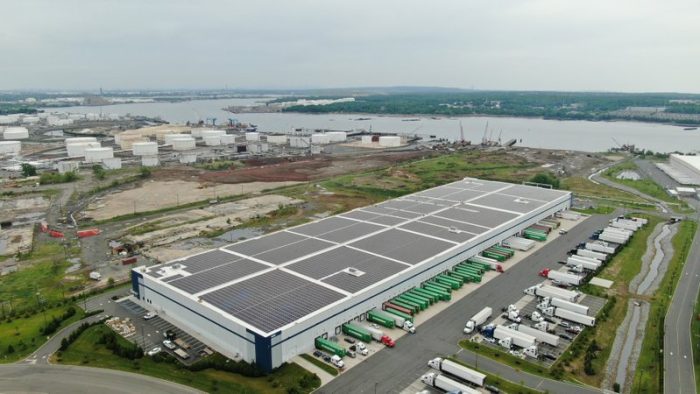Community Solar Project of the Year 2021: Duke Realty Portfolio

New Jersey | 11 MW
Our Community Solar Project of the Year, as decided by the readers of Solar Builder, highlights the power of progressive public policy to encourage renewable energy projects that are truly beneficial to the community, in terms of energy, equity and jobs.
Developer / Contractor: Solar Landscape
Modules: ZnShine, JA Solar, Q Cells
Inverters: SMA, SolarEdge
Mounting: Panel Claw
Background: When New Jersey’s three-year Community Solar Energy Pilot Program launched, allocating 75 MWdc in year one, Solar Landscape was first in the door. Duke Realty and its massive rooftop space in the area seemed like a perfect place to start.
“We’ve looked at a couple different options for solar on some of our roofs, but this is our first community solar project that we’ve done,” says Megan Basore, VP of corporate responsibility for Duke Realty. “It was a unique opportunity for us to take a different approach and test it out. Shaun and Solar Landscape approached us about it and then did the brunt of the legwork.”
It would eventually become the first completed community solar project in New Jersey under the program.
Energy and equity
In total, Solar Landscape installed nearly 11 MWdc of solar energy on four Duke facilities in three different municipalities, but what stands out most is the sheer volume of households benefiting — 1,800 New Jersey households. Part of that was the N.J. program, which mandated every subscriber base consist of 51 percent low- to moderate-income (LMI) households (a great concept). From there, Solar Landscape decided to forego an anchor subscriber and generate all of that PV for community residents, which is a cool but more difficult task to pull off, notes Shaun Keegan, founder and CEO of Solar Landscape.
“When you’re dealing with a new program, people will be skeptical, so you have to sell them on the benefits of that program, especially when it looks and feels like retail energy, which people are commonly approached about here in New Jersey,” he says. “Our biggest hurdle is getting people’s heads wrapped around how it works and that this isn’t retail energy. It really is a local clean energy source.”
Keegan credits their roster of nonprofit partners for making it possible to both skip the anchor subscriber and to identify and inform so many LMI customers about solar and the program itself.
“The mandate was reaching 51 percent LMI, and it’s hard to figure out who is in that category through direct mail,” he says. “The best way we’ve found is to partner with organizations like the Boys and Girls Club of Newark. We incentivize them to educate their members about how this all works. We decided to go 100 percent residential because we have these really competent partners helping us reach it.”
Jobs

Further setting this project portfolio apart from the pack was a built-in jobs training initiative.
“Our background is as a builder and installer of solar panels, and we’ve grown organically to be a developer-owner-operator, but we still employ over 50 electricians and installers,” Keegan says. “With a shortage in the skilled labor pool for solar, we partnered with GAF and added solar installation components to their existing roofing curriculum.”
Here again, Solar Landscape utilized its nonprofit partners — Edison Jobs Corp., Isle of Trenton, Interfaith Neighbors, the Jewish Renaissance Foundation, and other community-based organizations — to promote the jobs training component. The jobs training helped cinch Duke Realty’s interest in the deal.
“Sustainable development for us has different approaches,” Basore says. “How does it impact the community? How does it impact the environment? And how will it impact our tenants? This hit on a lot of those. The job training was a huge thing for me personally.”
Solar Landscape trained more than 100 solar installers as a result of the project and has since baked it into its company ethos, hiring a full-time jobs trainer.
“We really like training the workforce of the future,” Keegan notes. “We hired about eight people from the training, but we have a great network. So, when we complete a jobs training, we forward along those résumés, and a lot of them have been hired.”
The training grows the state’s clean energy workforce by introducing residents to the green energy economy, while providing hands-on experience and employment opportunities.





Comments are closed here.